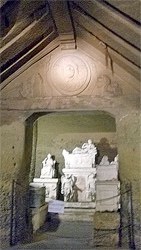
The hypogeum of the Velimna (in Latin, Volumni) family was discovered in 1840 at what proved to be the edge of the Palazzone Necropolis, about 6 kilometres southeast of Perugia, on a slope that descends to the Tiber. Very few grave goods were found in place, which suggests that the hypogeum had been violated at an earlier date.

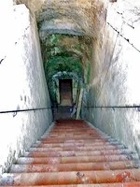
The inscription that can still be seen on the right door jamb of the entrance reads:
arnth larth velimnas/ arzneal husiur/ suthi acil hece (CIE 3754)
Arnth [and] Larth Velimnas, sons of Arzni, placed [this] tomb [and] gifts [here]
Arznei was the mother of Arnth and Larth: as we shall see below, their father was Aule.
The layout of the hypogeum is similar to that of an Etruscan villa:
-
✴The main entrance (illustrated at the top of this page) opens into a large central atrium, the ceiling of which imitates a pitched wooden roof. The relief above the entrance depicts a medusa between dolphins.
-
✴The room beyond, which corresponds to the tablinum (dining room), still contains the seven urns (see below) discovered in 1840.
-
✴There are two smaller rooms to each side of the tablinum and two more off each side of the atrium. These were presumably intended to house the urns of later generations, but they seem never to have been used. Indeed, some of them were never finished.
Each of the rooms of the hypogeum has a coffered ceiling and a shelf carved into the rock on which urns could be placed. [Two of them have Medusa's heads in shields on the ceiling, and a crested snake projecting from the wall. One of these rooms has an owl in relief in each corner, and a snake's head below it.]
Cinerary Urns in the Tablinum
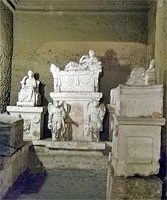
The tablinum contains seven urns, six of which are made of travertine covered with stucco decoration. In each of these, the ashes are interred in a high pedestal, with the deceased reclining (or in one case sitting) above and identified by an Etruscan inscription (CIE 3757-63).
Arnth Velimnas, son of Aule
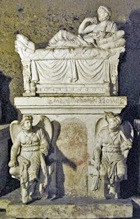
arnth velimnas aules (CIE 3761)
Arnth Velimnas, son of Aule
Arnth (like his male relatives to the right) is shown on the lid, reclining on an elaborate couch, as if at a banquet. Two winged demons that are carved in deep relief on the front of the urn guard the frescoed door to Hades, where figures of his ancestors (badly damaged) wait to greet him.
Male Relations of Arnth Velimnas
The four urns to the right belong to male relatives of Arnth.
Thephri
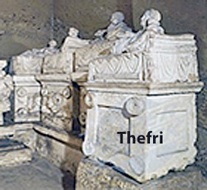
The urn at the extreme right is inscribed:
thephri velimnas tarchis clan (CIE 3757)
Thephri Velimnas, son of Tarchis
This urn much simpler than the others and is oddly detached near the entrance to the tablinum, which suggests that it was moved here from its original location. It is usually assumed that Thephri was the grandfather of Arnth and his brothers, and that he was originally buried elsewhere: his urn would have been moved here when the hypogeum was built.
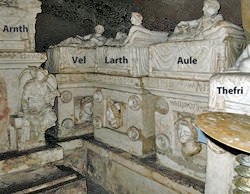
Aule
Proceeding anti-clockwise from the urn of Thephri, the next urn is inscribed
aule velimnas thephrisa nuphrznal clan (CIE 3758)
Aule Velimnas, son of Thephrisa and Nuphrznal
It seems liklely that Aule was father of Arnth and his brothers
Vel and Larth
The two urns between that of Aule and that of Arnth (still proceeding anti-clockwise) are inscribed:
larth velimnas aules (CIE 3759)
vel velimnas aules (CIE 3760)
Respectively, Larth and Vel Velimnas, sons of Aule
The urns of Vel, Larth and Aule are very similar: each of these men reclines (like Arnth) on the lid of his urn, so that they seem to be sharing a meal. Since Vel’s urn is the closer of the two to that of Arnth, Vel presumably died before Larth, albeit that he was not named as a founder of the hypogeum and thus was probably the youngest of the brothers,
Veilia Velimnei Arnthial
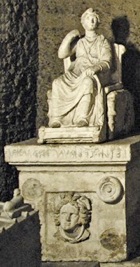
veilia velimnei arnthial (CIE 3762)
Veilia Velimnas, daughter of Arnth
History of the Hypogeum
Enzo Lippolis (referenced below, at p. 150) dated the hypogeum to the late 2nd or early 1st century BC. As he pointed out, it had clearly been intended for use in future generations, but (as discussed below) it was only used one one subsequent occasion. Arnth Velimna had clearly been the prime mover in this project: Lippolis suggested that he had chosen the wrong side in the civil war of 87-79 BC, following which the family lost access to the tomb. This interruption was prolonged by the turmoil of the Perusine War (41-40 BC) and family access to the hypogeum only became possible after the city was restored to favour in at the start of the 1st century AD as Augusta Perugia. As we shall see, only one member of the family was buried here thereafter.
Publius Volumnius Violens, son of Aulus
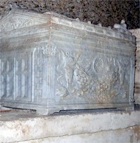
-
“Fashioned out of [Luna] marble ..., this monument is constructed in the shape of a Roman temple, with each of its sides giving the viewer an impressionistic glimpse of typical temple rituals ... Both material and decoration [thus] closely copied the inner precinct walls of the Ara Pacis (altar of peace), dedicated in 9BC [in Rome] in celebration of [Augustus’] pacification of the world.”
As Osgdood observed (at p. 181), even in Rome it would have been in the most “modern” style of its day.
Despite the very Roman character of the urn, it has a bilingual funerary inscription:
-
✴The Latin inscription (CIL XI 1963, 10 BC - 10 AD) on the architrave of the fictive temple identifies the deceased as:
-
P[UBLIUS] VOLUMNIUS A[ULI] F[ILIUS] VIOLENS/ CAFATIA NATUS
-
Publius Volumnius Violens, son of Aule and Cafatia
-
✴The Etruscan inscription (CIE 3763), which also uses the Etruscan alphabet, appears on the lid of his urn:
pup[li] velimna au[le] cahatial
-
Thus the family name ‘velimna’ was Latinised as Volumnius, and the Etruscan "cahatial" must have had the same meaning as the Latin "cafatia natus". (The Etruscan inscription is put into context in the page on Etruscan Inscriptions after 295BC.)
The use of the Etruscan language at this late date (and the use of a matronymic in the Latin form of the name, redolent of Etruscan practice) is most unexpected, particularly on such a self-consciously Roman monument. Clearly we are dealing here with a cultured and thoroughly Romanised individual who was nevertheless keen to display and to remind his descendants of the family’s Etruscan roots.
The first question that arises here is why Publius Volumnius chose to be buried in a hypogeum that had not been used for some 100 years:
-
✴The most likely reason is that he was a direct descendant, through the paternal line, of Thephri Velimnas, son of Tarchis.
-
✴However, that leaves us wondering why, in that case, his father Aule (and any other members of Aule’s generation of the family) had not been buried here.
It seems to me that the most likely explanation is that the family had lost their land here, most probably during the Sullan proscriptions of 82 BC, and had only regained it in the closing years of Publius’ life. In this scenario, his urn would have been a celebration of the family’s reconnection with its ancient property and its Etruscan heritage. (That still leaves open the question of why Publius did not rebury his father in the recovered family hypogeum, which must remain a matter for speculation.)
The next question concerns the reason for the family’s putative change of fortunes. The answer to this might be indicated by the fact that Publius’ eponymous son (see below) held the supreme magistracy at the time that the city was ‘restored’ as Augusta Perusia, probably early in the 1st century AD: as Maria Carla Spadoni (referenced below, at p. 704) pointed out, this was a sure sign that, unlike many Perugian aristocratic families, the Volumnii (including Publius Volumnius, son of Aule) had supported Octavian during the Perusine War. After the war, the current owners of this land outside Perusia would have suffered its confiscation, and it is not difficult to imagine that Octavian would have returned it to the Volumnii in gratitude for their support.
Publius had probably enjoyed high social status even before his good fortune following the Perusine War: as Maria Carla Spadoni (referenced below, at p. 704) observed, his mother, Cafatia was:
-
“... an exponent of an aristocratic gens whose tomb was in the Palazzone necropolis, not far from that of the Velimna” (my translation).
It is difficult to imagine that she and Aule would have married unless his family had recovered to an appreciable extent from their earlier misfortunes. Publius‘ recovery of the family’ hypogeum (and presumably a surrounding estate here) would have added to his prestige at a time when most of his erstwhile peers were facing catastrophe. His magnificent urn speaks volumes for his wealth by the time of his death, while his position at the apex of Perugian society is demonstrated by the fact that, as mentioned above and discussed further below, his eponymous son attained the supreme magistracy of the city.
One final thing to consider is Publius’ Roman cognomen, Violens, which implied descent from Lucius Volumnius Flamma Violens, who had been the first plebian to become consul in Rome, in 307 BC. However, Maria Carla Spadoni concluded (at p. 706) that there was:
-
“... no direct link between [the senatorial Roman Volumni] and the gens Volumnia of Perusia, which did not reach its peak until the third century BC, when it joined the ranks of the local aristocracy.”
Despite his Romanised name and his Roman urn, Publius roots were in Perusia, as was demonstrated by the very successful but entirely municipal career of his son.
Other Members of the Volumni Family
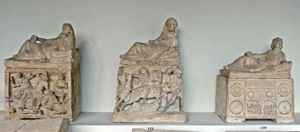
Nine urns belonging to women of the Velimnas family, which probably pre-date the urns in the Ipogeo dei Volumni, were discovered in 1797 in another hypogeum on this site. Three of them are exhibited in the Museo Archeologico (exhibits 124-6, above).
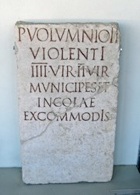
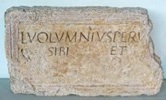
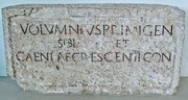
CIL XI 2085 CIL XI 1957
Two funerary inscriptions also in the Museo Archeologico (exhibits 243-4) commemorate later members of the family:
-
✴Part of the travertine funerary inscription (CIL XI 2085, 1st half of the 1st century AD) of Lucius Volumnius Perusinus (243) came from an unknown location.
-
✴The funerary inscription (CIL XI 1957, 1st century AD) of Volumnius Primigenius and his wife Caenia Crescens (244) was found near the church of San Costanzo in 1742.
Read more:
M. C. Spadoni, “I Volumni Perugini : Senatori a Roma?”, in
M. L. Caldelli and G. L. Gregori, “Epigrafia e Ordine Senatorio, 30 Anni Dopo: Atti della XIX Rencontre sur l' Epigraphie du Monde Romain” (2014) Rome, pp 697-708
E. Lippolis, “L' Ipogeo dei Velimna-Volumni al Palazzone di Perugia: un Caso di Rappresentazione Familiare e il Problema Interpretativo”, in
L. Cenciaioli, (Ed.), “L' Ipogeo dei Volumni: 170 anni dalla Scoperta: Atti del Convegno di Studi (Perugia, 10-11 giugno 2010)”, (2011) Città di Castello, pp. 135-166
J. Osgood, “Caesar’s Legacy”, (2006) Cambridge
Palazzone Necropolis Ipogeo dei Volumni Antiquarium del Palazzone.
Return to Museums of Perugia.



